Contents
- Introduction
- Government sources – Australian
- Government sources – United States
Introduction
RAAF Base Darwin is co-located with Darwin International Airport bordering Stuart Drive, Darwin. It is home to a number of RAAF units, and is frequently used by USAF and US Marine aircraft, as well as Republic of Singapore Air Force planes. The US aviation presence at RAAF Base Darwin and RAAF Base Tindal near Katherine has grown considerably since 2011.
Nuclear-capable B-52 Stratofortress bombers exercise regularly through RAAF Darwin, visiting twice in 2018, and separately taking part in Exercise Pitch Black in mid-2018.
In December 2018 two US B-52s from the 96th Expeditionary Bomb Squadron (EBS) based at Barksdale AFB in Louisiana and a 50-person USAF support group took part in Exercise Lightning Focus ‘designed around improving, developing and integrating partner capabilities as part of the Enhanced Air Cooperation (EAC) under the Force Posture Initiative between the United States and Australia.’
The 96th EBS bombers flew from Andersen AFB in Guam where they are deployed on a 6 month rotation as part of a Continuous Bomber Presence (CBP) in the region that has been in place since 2004.
‘The employment of CBP missions in the USINDOPACOM area of responsibility, conducted since March 2004, are in accordance with international law and are vital to the principles that are the foundation of the rules-based global operating system.’
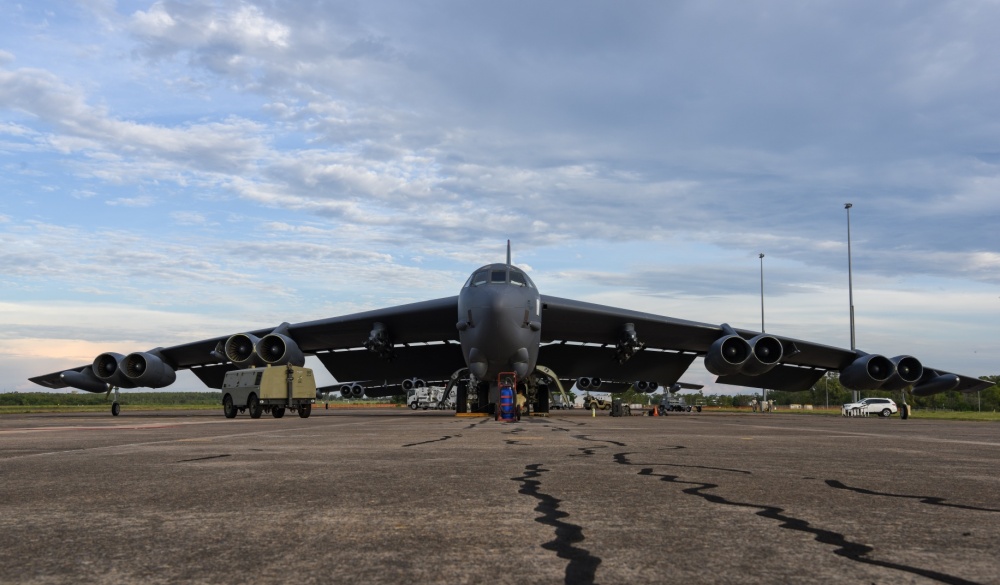
‘B-52 Stratofortress bombers arrive at RAAF Base Darwin‘, 29 November 2018.
The 2014 battalion-sized rotational deployment includes an Air Combat Element (ACE), consisting of approximately 100 personnel, four CH-53E Super Stallion helicopters from Marine Heavy Helicopter Squadron 463 (HMH-463), Hawaii, and Marine Aviation Logistics Squadron 24 (MALS-24). The ACE will be based at RAAF Darwin.
In late March and April 2018 three Guam-based USAF B-52 bombers were stationed at RAAF Darwin to take part in training with RAAF F/A-18A Hornets, PC-9 aircraft and Joint Terminal Attack Controllers in military airspace near RAAF Williamtown as part of the Enhanced Air Cooperation (EAC) initiative with the United States. According to the Department of Defence
‘The training provides the ADF with a valuable opportunity to integrate Royal Australian Air Force aircraft and ADF personnel with USAF B-52 Bombers in close air support scenarios.
EAC training exercises are designed to increase the ability of Australian and US air forces to operate together and to enhance security cooperation in the region.’
Location
12°24′53″S 130°52′36″
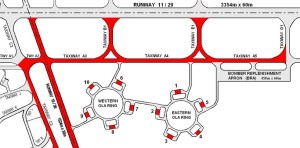
DAR airport limitations – OLA usage, Annexe E to Review, Civil aviation access to Air Force airfields, Royal Australian Air Force, September 2010
http://www.airforce.gov.au/docs/Civil%20Aviation%20Access%20to%20AF%20Airfields%20Final.pdf
RAAF Base Darwin, Wikipedia
Government sources
Australia
RAAF Base Darwin, RAAF
- No 396 Expeditionary Combat Support Wing
- No 92 Wing Detachment Darwin – surveillance and response
- No 452 Squadron Headquarters
- No 452 Squadron Darwin Flight – air traffic control
- No 13 (City of Darwin) Squadron
- No 1 Airfield Operations Support Squadron Detachment Darwin – air movements
- Darwin Area Health Centre
- No 2 Expeditionary Health Squadron Detachment Darwin
- No 114 Mobile Control and Reporting Unit – radar operations
Annex E to Review of Access to Air Force Airfields by Civil Aircraft, RAAF, September 2010,
Darwin and Townsville
82. Operational activity. Importantly, DAR and TVL airfields are FMBs for operations into Australia’s areas of interest to the north and the SW Pacific. They are critical for the support of Defence of Australia tasks. Operations into East Timor were mounted from these airfields over an extended period with high daily military movements at both locations. Numerous humanitarian operations have been mounted from or through DAR and TVL including support following the Bali bombings, tsunami support to SE Asia, and various humanitarian emergencies in New Guinea, and the SW Pacific. TVL supported operations in Papua New Guinea, Bougainville and the Solomon Islands. Of note, DAR is inextricably linked to TDL in the conduct of operational and exercise tasks in the northwest area by geography. 83. Routine defence activity. Both airfields are regularly used by Air Force, and Australia’s allies, for training and exercise purposes. DAR is critical to the conduct of large scale air exercises in Australia because of the availability of large volumes of airspace, proximity of Air Weapon Ranges and TDL airfield. No 5 Aviation Regiment is based at TVL airfield.
Air Force activity levels
84. Air Force activity levels at the Joint User airfields generally do not disrupt civil aviation activity due to limited use, and effective management processes employed by Air Force. However, significant scope exists for both exercise and operational activity to disrupt civil flying. And, notwithstanding the lack of large and permanent force element groups at these locations, future force consolidation at either one, or both, of these bases cannot be ruled out. The existing leases do not adequately explain the potential for disruption and leave Air Force open to significant criticism. Both DAR and TVL operate at capacity levels during Defence exercises, and a similar situation could arise during FMB operations. Both leases should be amended to more clearly apprise civil airport operators and users of potential traffic disruptors.
85. While operational airfields provide priority for military operations, Joint User airfields provide “mutual inconvenience.” Consequently the declaration of additional Joint User airfields is not recommended. Further, Joint User arrangements limit force element basing options, through estate availability, and subsequent surface manoeuvre area and airspace congestion.
Summary
86. Air Force operates two Joint User airfields, which are primarily used for exercises and operations. Both airfields are important FMBs and have Defence of Australia obligations. They both host large exercises, with DAR being particularly important to the larger scale exercises with Allied Forces in the northern training airspaces. Major force elements are not currently based permanently at these airfields, therefore civil aviation access is not routinely disrupted under present arrangements. However, and as discussed previously, future force consolidation at either location cannot be ruled out.
United States
Jackie Sanders, ‘U.S., Australian air forces advance combined capabilities at Darwin’, DVIDS, 12 September 2018,
Two U.S. Air Force B-52 Stratofortress bombers and approximately 50 Airmen, assigned to the 96th Expeditionary Bomb Squadron, concluded a combined exercise with the Royal Australian Air Force (RAAF) at RAAF Base Darwin, Australia, Dec. 9, 2018, in support of exercise Lightning Focus.
Exercise Lightning Focus is an Australian training exercise designed around improving, developing and integrating partner capabilities as part of the Enhanced Air Cooperation (EAC) under the Force Posture Initiative between the United States and Australia. While at RAAF Base Darwin, the B-52s participated alongside RAAF F-18 Super Hornets in a wide range of exercise and training activities, conducting multiple combined sorties and providing input into expanding and developing tactics and procedures.
Through the EAC initiative and the continued enhancement of the RAAF facilities, Pacific Air Forces and the RAAF continue to build upon their already strong alliance and combined capabilities, advancing interoperability between the nations.
The bombers previously participated in an EAC event focused on close air support exercises with Australian Army and RAAF units in April 2018.
Christopher Quail, ‘B-52 Stratofortress bombers arrive at RAAF Base Darwin‘, DVIDS, 29 November 2018
‘U.S. Air Force members from the 96th Expeditionary Aircraft Maintenance Unit shake a tow bar to maneuver it into place on a B-52 Stratofortress bomber during exercise Lightning Focus at Royal Australian Air Force (RAAF) Base Darwin, Australia, Nov. 29, 2018. Two bombers along with aircrew and support personnel deployed to RAAF Darwin to enable the U.S. to train and increase interoperability with Australian counterparts in support of U.S. Indo-Pacific Command’s Enhanced Air Cooperation (EAC) program. The EAC comprises a range of air exercises and training activities designed to enhance regional cooperation, coordination and interoperability between Australian and U.S. service members. (U.S. Air Force photo by Senior Airman Christopher Quail)
OIC of MRF-D talks about upcoming rotation, DVIDS, 25 March 201
MRF-D Marines take off to Bradshaw, Sgt. Sarah Fiocco, DVIDS, 28 August 2013
Marines with Marine Rotational Force – Darwin took off to Bradshaw Field Training Area for Exercise Koolendong on four MV-22B Ospreys from Marine Medium Tiltrotor Squadron 265, 31st Marine Expeditionary Unit, here, Aug. 28. Exercise Koolendong is a bilateral training evolution in which Marines with Marine Rotational Force – Darwin and the 31st MEU will work with Australian soldiers from Bravo Company, 5th Battalion, Royal Australian Regiment from Aug. 31 to Sept. 5. “It’s the first time that we’re actually going out to Bradshaw Field Training Area,” said Lt. Col. Matthew Puglisi, officer-in-charge, Forward Coordination Element, MRF-D. “It’s really our ‘proof of concept’ exercise. It’s allowing us to take a look at what we need and what we can actually do out there.” The training evolution at BFTA took the Marines on 350-mile journey. That kind of travel distance required many months of preparation. “For the past six months, we’ve been doing a lot of planning,” explained Puglisi. We’ve done two sight surveys, and we met with the traditional landowners. We also just completed the set up of four ranges.” With approximately 1,000 Marines and Australian soldiers participating in Exercise Koolendong, service members will have the opportunity to use different training components. “The infantry guys will be participating in dismounted and mounted attacks and will be backed up by close air support,” said Puglisi. “We’ll also have some light-armored vehicles conducting attacks on the objectives.” MRF-D Marines have kept this training evolution in mind throughout their time at different Defence training locations in Australia. “The whole deployment so far has been in preparation for going out to do complicated attacks like this at Bradshaw,” said Capt. Raymond L’Heureux, commanding officer, Lima Company, 3rd Battalion, 3rd Marine Regiment, MRF-D. “Everything we’ve done at Kangaroo Flats Training Area and all the rehearsals we’ve done in between have been to do an exercise of this level.” Exercise Koolendong is the culminating event of the 2013 Marine rotation Down Under. “It’s the final event we have here for our deployment down in Australia,” said L’Heureux. “It’s a unique training opportunity. All in all, it’s going to be a good exercise.”
MV-22B Osprey, 31st MEU, RAAF Base Darwin
2013
Housing for US Marines to be built at ADF base, Lorraine Davies, ABC News, 20 September 2013
The Federal Government is pushing ahead with plans to build accommodation at Australian Defence Force bases in Darwin to house US Marines. In June, the Government announced that it had agreed with the US that there would be a six-month rotation of almost 1,200 Marines to northern Australia from next year. In preparation, a first-stage $12 million tender has been let for the construction of sleeping and working quarters at two bases. The accommodation would be for about 200 Marines at the army’s Robertson Barracks, and for about 130 Marines at the Darwin RAAF base.
2011
Republic of Singapore Air Force F-15SG Eagle Jets at Darwin RAAF, Darwin Airport, Darwin, Northern Territory, Michael J. Barritt, Flickr, photo taken on April 15, 2011
Project coordinator: Richard Tanter
Updated: 1 December 2018


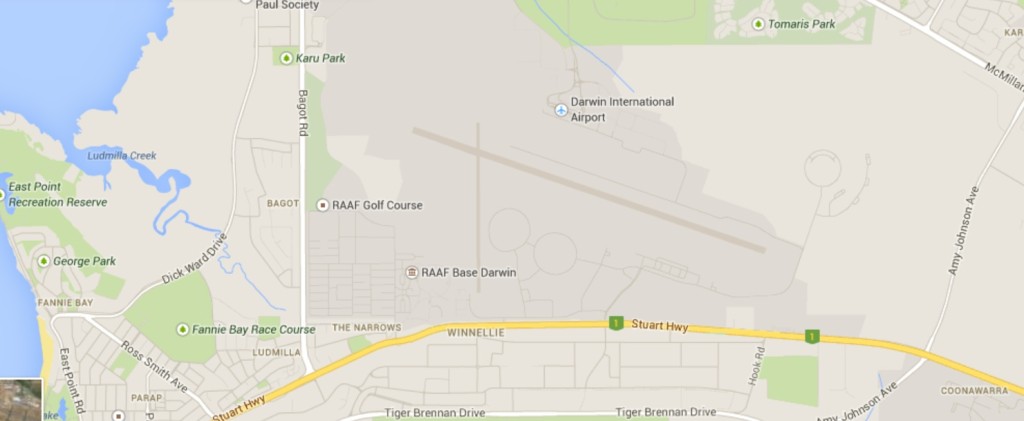
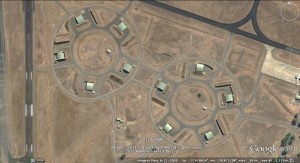
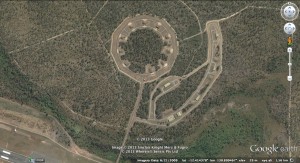
Is there an email address to contact the raaf Darwin base by?
Hi Zan, I don’t know it. You could just the Defence Dept on 1300 333 362 and ask to be put through to RAAF Darwin.